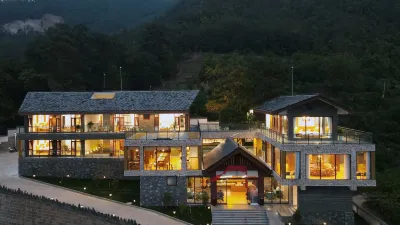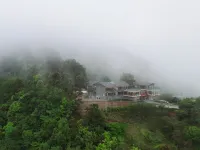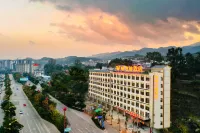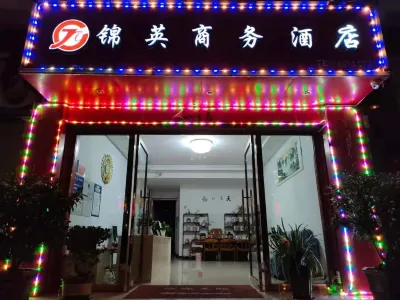
Best Jingdong Hotels
Enter your dates for prices and availability of the best hotels in Jingdong.
Hot travel dates
Today
Tomorrow
Next Weekend
Apr 2025
- Sun
- Mon
- Tue
- Wed
- Thu
- Fri
- Sat
- 1
- 2
- 3
- 4
- 5
- 6
- 7
- 8
- 9
- 10
- 11
- 12
- 13
- 14
- 15
- 16
- 17
- 18
- 19
- 20
- 21
- 22
- 23
- 24
- 25
- 26
- 27
- 28
- 29
- 30
May 2025
- Sun
- Mon
- Tue
- Wed
- Thu
- Fri
- Sat
- 1
- 2
- 3
- 4
- 5
- 6
- 7
- 8
- 9
- 10
- 11
- 12
- 13
- 14
- 15
- 16
- 17
- 18
- 19
- 20
- 21
- 22
- 23
- 24
- 25
- 26
- 27
- 28
- 29
- 30
- 31
Swipe up to view more
Filter by:
Hotel Star Rating
≤2345
Popular Filters
Amazing 4.5+Great 4.0+Good 3.5+Pleasant 3.0+78 Best Hotels to Stay in Jingdong
Select your travel dates for best hotels in Jingdong, featured by Trip.com based on guests reviews!
Most Booked
Lowest Price
Closest to Downtown
Highest Rated



Hotel near Jingdong
GGuest User 2024.04.26
This is a super nice mid-mountain hotel located deep in the mountains of Huangcaoling. I stayed there for two nights and still felt satisfied. Each room has a nice name, and I especially recommend Tingyuan-2. Super large room, super large terrace, excellent privacy and great value for money. You can sit quietly for a whole day, facing the mountains that are layered like ink paintings, the lush vegetation of the primeval forest, and listen to the wind, birds and monkeys. The guys and girls at the front desk are all local young people, simple, enthusiastic, talkative and professional. They are more humane than star-rated hotels. It is the cherry harvest season now. The sweet and juicy cherries paired with the black-bone chickens from the nearby farmhouse make this secret hotel the best choice for vacation and leisure.
Outstanding
69 reviews
4.7/5
Price from
PHP 1,507
per night



Hotel near Jingdong
The ZhiHe Hotel is an ideal spot for travelers wanting to discover the city. The ZhiHe Hotel offers a pleasant stay in Jingdong for those traveling for business or leisure. Seeing Jingdong's sights from this hotel is easy with Taofu Culture Square, Jingdong Kongqueshan Forest Park and Nanyue Plaza all close by. At the end of a busy day, travelers can unwind and relax in the hotel or go out and enjoy the city. Guests of this Jingdong hotel can make use of the parking facilities. Germaphobes can rest easy - the level of cleanliness is highly rated at this hotel. This hotel is the usual choice for a large number of business travelers.
Outstanding
145 reviews
4.6/5
Price from
PHP 1,010
per night



Hotel near Jingdong
GGuest User 2025.03.04
This trip stayed at Jingdong Geyue Binya Hotel, the experience was great! The price is very high, and its advantages in the same price hotel are very prominent. The room was clean and tidy, the bed was soft and comfortable, the spotless floor and the white sheets made people relax instantly. The bathroom also has no smell, and toiletries are all available. The public area has an elegant environment, the service staff is warm and thoughtful, and the check-in and check-out are very fast. Whether it is business travel or leisure travel, this hotel is a great choice, highly recommended to friends who are looking for comfort and pay attention to cost-effective!
Outstanding
229 reviews
4.7/5
Price from
PHP 1,134
per night

You Might Like
Jingdong Hotels With BreakfastJingdong Hotels With Twin RoomJingdong Hotels With 1 Double BedJingdong Hotels With Swimming PoolJingdong Hotels With Free Cancellation



Hotel near Jingdong
GGuest User 2025.03.28
Bring your children to Wuliangshan Gibbon Resort Hotel for vacation, the experience is great! The hotel environment is integrated into nature, and the mountains and birds sing when you open the window. Children especially like parent-child activities here, especially kite painting and sachet production. The room is spacious and clean, the bedding is soft and comfortable, suitable for a family to relax. The staff is intimate and welcoming, the check-in is fast and efficient, and the tour route of the park is also actively recommended. In short, it is a relaxing and fulfilling parent-child trip, it is recommended!
Very Good
91 reviews
4.2/5
Price from
PHP 4,724
per night



Hotel near Jingdong
XXuan… 2025.01.21
The feeling of staying at this hotel today is very good, the design is very strong, it can be seen that the taste of the hotel is very good. Secondly, the hotel's hardware facilities and software facilities are very good. Many of the facilities in the room are branded, especially the shower, the bath is very good. Hotel service is very good, especially the front desk Miss Luo Wei is very intimate, the hotel takeaway can be delivered to the room is very convenient, do not need to go downstairs to pick up.
Outstanding
635 reviews
4.8/5
Price from
PHP 1,515
per night



Hotel near Jingdong
GGuest User 2024.12.21
Facilities: very luxurious
Hygienic: very clean
Environment: very beautiful
Service: Very intimate
Outstanding
104 reviews
4.7/5
Price from
PHP 1,111
per night



Hotel near Jingdong
GGuest User 2024.02.14
The hotel is very close to the Temple of Confucianism and the surrounding area is very convenient. And the sound insulation is excellent. The rest is very good. There is a special early peanut soup and thin powder downstairs. I like it so much. And the customer service lady is very good, people are kind
Outstanding
136 reviews
4.8/5
Price from
PHP 1,064
per night



Hotel near Jingdong
GGuest User 2024.05.19
The breakfast at Jinfeng Hotel in Jingdong Yi Autonomous County is varied and nutritious, although I don't like to eat very much; the restaurant is bright and tidy, the most worthy of recognition is: breakfast is steaming 👍😁
Parking lot small garden 👍 Hydrangea, Sun Flower, Yellow Bell Flower, Dragon Boat Flower...[happy]
Excellent
107 reviews
4.4/5
Price from
PHP 1,064
per night



Outstanding
10 reviews
4.6/5
Price from
PHP 357
per night



Hotel near Jingdong
GGuest User 2023.06.24
I like this place very much. I really like it. I like it. I like it. I like it. ................................
40 reviews
3.9/5
Price from
PHP 668
per night
What Travelers Said About the Best Hotels in Jingdong
See all
Browse these genuine traveler ratings and real guest reviews to find the best Jingdong hotels.
4.8/5
Outstanding
GGuest UserThe hotel is very close to the Temple of Confucianism and the surrounding area is very convenient. And the sound insulation is excellent. The rest is very good. There is a special early peanut soup and thin powder downstairs. I like it so much. And the customer service lady is very good, people are kind
4.8/5
Outstanding
GGuest UserThe hotel is hidden in the mountains, surrounded by cherry blossoms, succulent roads, and there is a sugarcane forest in front. Standing on the second floor to take pictures, the scenery is excellent. The boss was warm and thoughtful and helped us upgrade the room. The room was clean and tidy, smart and comfortable. We just happened to catch up with the chess game, the boss invited us to dinner and breakfast together, the taste is quite good, the most special is the dragon fruit sweet wine juice, now are unforgettable.
4.7/5
Outstanding
GGuest User#LocationTransportation#Room Facilities#Health#Services are all good
4.7/5
Outstanding
GGuest UserThe hotel environment is clean and hygienic~ convenient parking~ wifi is easy to use~ a middle-aged couple boss is enthusiastic and patient for traveling abroad, hair dryer and 24-hour hot water are great benefits~ conscience recommends affordable hotels
4.6/5
Outstanding
爱爱生活爱自己yeGenerally, just stay for one night!
4.4/5
Excellent
GGuest UserThe breakfast at Jinfeng Hotel in Jingdong Yi Autonomous County is varied and nutritious, although I don't like to eat very much; the restaurant is bright and tidy, the most worthy of recognition is: breakfast is steaming 👍😁
Parking lot small garden 👍 Hydrangea, Sun Flower, Yellow Bell Flower, Dragon Boat Flower...[happy]
4.4/5
Excellent
GGuest UserThe room facilities are fully equipped, a few meters away is the park. Very good.
3.9/5
GGuest UserI like this place very much. I really like it. I like it. I like it. I like it. ................................
3.8/5
GGuest UserThe hotel is very good, all aspects of service are meticulous and thoughtful, suitable for staying
3.3/5
GGuest UserGenerally okay
FAQs About Jingdong Hotels
Where is the best place for a stay in Jingdong?
Jingdong has some of the best hotels for you to select. Whether you're traveling for business or on a vacation, Jingdong Boundless Hotel, Jingdong Bafu Hotel and Jingdong Kerry Hotel are preferred hotels.
What is the average hotel fee in Jingdong?
For hotels in Jingdong, the average price on weekdays is PHP 1,095, the average price on weekends (Friday–Saturday) is PHP 1,094.
Which hotels in Jingdong has the best breakfast?
Huangcaoling Wuliang Secret Hotel,Jinlian Mountain Rooms and Huangma Hotel provide high-quality breakfast. Start your day with fresh, delicious breakfast!
What's the best place to stay for family vacations in Jingdong?
Bingyingge is a top choice for family vacation. Enjoy a trip together with your kids and other beloved family members!
What are the best hotels with gym and fitness center in Jingdong?
Jingdong Boundless Hotel, Jingdong Bafu Hotel and Jingdong Kerry Hotel provide fitness facilities. Boost your fitness during your travel time!
What's the best pet-friendly accommodation in Jingdong?
Huangcaoling Wuliang Secret Hotel allows pets. Take your pets with you during your stay!
What are some hotels with pools in Jingdong?
Huangcaoling Wuliang Secret Hotel is a hotel with swimming pools. Stay at any of these hotels to enjoy a swimming pool!
Which hotels in Jingdong provide free Wi-Fi?
Whether you're traveling on business or for vacation, internet connection is essential. Jingdong Boundless Hotel, Jingdong Bafu Hotel and Jingdong Kerry Hotel are popular hotels with free Wi-Fi.
Which hotels in Jingdong provide airport transfers?
Worried about getting lost in Jingdong? Jingdong Boundless Hotel, Jingdong Bafu Hotel and Jingdong Kerry Hotel provide airport transfer services.
What is the best spa hotel in Jingdong?
Getting tired after a long walk? Jingdong Boundless Hotel, Jingdong Bafu Hotel and Jingdong Kerry Hotel provide highly rated spa services.
Where to find hotel deals in Jingdong?
Trip.com provides various promotions and discounts for users all year round. You can check the promotions page to see what promotions are available on Trip.com.
Jingdong Hotels Info
| Highest Price | PHP 4,662 |
|---|---|
| Lowest Price | PHP 451 |
| Number of Reviews | 3,226 |
| Total Properties | 78 |
| Average Price (Weekdays) | PHP 1,095 |
| Average Price (Weekends) | PHP 1,094 |
Keep Exploring Jingdong
Popular Cities
Hotels in AyangueHotels in BataHotels in CockpitHotels in WillastonHotels in WalworthHotels in Montferrier-sur-LezHotels in AnchialosHotels in BellevilleHotels in OrangevilleHotels in MeddersheimHotels in PhiladelphiaHotels in L'Aiguillon-sur-VieHotels in VernantesHotels in Bruchhausen-VilsenHotels in Beersel